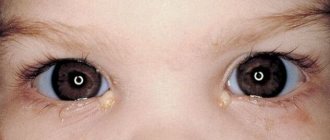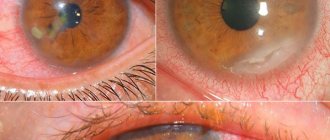Bacterial conjunctivitis is an eye disease caused by various pathogenic microorganisms. It is transmitted through household contact and airborne droplets and, if not treated promptly, can lead to negative consequences for the eyes. Let's consider the types of this pathology, methods of therapy, and preventive measures.
Bacterial (purulent) conjunctivitis begins to develop when pyogenic (pus-producing) bacteria enter the human body. These can be staphylococci, streptococci, gonococci, chlamydia, Pseudomonas aeruginosa and other microorganisms.
In this article
- Chlamydial conjunctivitis
- Purulent conjunctivitis in children
- Spread of bacterial and viral conjunctivitis in adults and children
- What are the dangers of bacterial conjunctivitis?
- Medicines to eliminate bacterial conjunctivitis
- Prevention of conjunctivitis
The main symptom of the disease is thick, opaque, purulent discharge from the eyes, which usually causes the eyelids to stick together, especially in the morning after sleep. In addition, conjunctivitis of bacterial etiology is characterized by other symptoms:
- swelling and hyperemia of the eyelids;
- photophobia, burning and pain in the eyes;
- dry skin around the organs of vision;
Bacterial conjunctivitis usually occurs in one eye, and within a day or two it affects the other eye. Pyogenic infections are also characterized by acute pain. Even a newborn child can suffer from this type of conjunctivitis, having become infected from the mother during childbirth. Particularly severe inflammation in infants is caused by gonococci and chlamydia.
If treatment for bacterial conjunctivitis is not started in time, the disease can become chronic, and then it will take a long time to get rid of the symptoms. The most severe damage is caused by gonococci and Pseudomonas aeruginosa. Untimely treatment can lead to severe ulceration of the cornea, which can cause permanent loss of vision.
What triggers the development of bacterial conjunctivitis?
Bacterial or viral conjunctivitis can develop against the background of a cold or infectious disease. The combination of a runny nose and conjunctivitis is especially common, because pathogenic bacteria quickly spread to other organs, and due to the proximity of the nose and eyes, this happens quite quickly. A bacterial infection can also enter the eyes through dirty hands, dirty handkerchiefs, and household items that are used simultaneously by both sick people and their healthy environment. Treatment with herbal decoctions and other folk remedies in this case will not be effective due to the rapid spread of infection and the release of toxins by bacteria.
Frequent causes that provoke the development of bacterial and viral conjunctivitis:
- complication of colds and viral diseases;
- hypothermia, overheating of the body;
- reduced immunity, chronic diseases, systemic disorders;
- infection through a medical instrument during diagnosis or treatment of other ophthalmological diseases can also cause viral or bacterial inflammation of the eye mucosa;
- dry eye syndrome, which occurs as a result of excessive visual stress, can lead to viral or bacterial conjunctivitis;
- contact lenses, rules for their cleaning and disinfection.
Why do some people often become infected with bacterial or viral conjunctivitis, while others do not? In order for pathogenic flora to overcome the natural barriers of the body, appropriate conditions must be created for the life of bacteria. The human visual organs become vulnerable if the amount of tear fluid is insufficient. This usually happens with dry eye syndrome, ophthalmological problems, reduced immunity, during dry, hot and windy weather, when the mucous membrane of the eye dries out, as well as colds accompanied by elevated temperature, which causes a lack of moisture in the body and a person feels discomfort in the eyes. Remember that if folk remedies do not help relieve irritation, and the symptoms increase, you should urgently contact an ophthalmologist.
Useful video
From this video you will learn more about conjunctivitis:
Pneumococcal and staphylococcal conjunctivitis is a contagious disease that is very easy to catch by communicating with an infected person.
Each type of disease requires immediate treatment , as in most cases it occurs in children.
Untimely and erroneous treatment can lead to serious complications, including vision impairment.
Pneumococcal conjunctivitis is one of the most common eye diseases, most often found in children. This pathology has several features, the main one of which is the ability to take on the character of epidemics, especially in the cold season. The human eye has a protective mucous membrane - the conjunctiva, the inflammation of which is called conjunctivitis.
According to the course of inflammation, acute and chronic conjunctivitis of an infectious and non-infectious nature are distinguished. Today, this disease is quite well studied and can be easily treated. The main task of an ophthalmologist is to determine the type and degree of development of conjunctivitis and prescribe appropriate treatment.
What bacteria affect the mucous membrane of the eyes during conjunctivitis?
Most often, staphylococci, streptococci, gonococci, pneumococci, and diphtheria bacilli are found in eye diseases. All these microbes can affect not only the conjunctiva, but also other parts of the eye. Therefore, treatment with folk remedies for conjunctivitis is not always effective without the use of antimicrobial drugs. If the organs of vision function normally, and the lacrimal gland secretes a sufficient amount of moisture, then there are no conditions for the spread of microbes, since tears have an antibacterial effect. Lysozyme, which is part of the tear fluid, neutralizes the effects of bacteria and viruses, preventing toxins from having a detrimental effect on the body.
When the body's defenses are weakened, bacteria can spread rapidly and can only be combated with antimicrobial drugs. Unfortunately, it will not be possible to cope with a bacterial eye infection with folk remedies. Streptococcus, overcoming the natural barriers of the body, spreads and releases toxins, which, when released into the blood, can cause, in addition to conjunctivitis, other inflammatory processes, which leads to general intoxication of the body. How to treat bacterial conjunctivitis? The harmful effects of bacteria must be stopped as soon as possible, since the poisons they secrete can dilate blood vessels and destroy blood cells, negatively affect white blood cells, reducing the body’s ability to resist infections, and also secrete enzymes that help bacteria spread quickly.
This is why bacterial conjunctivitis is treated with broad-spectrum antibiotics, and their use is not only desirable, but actually necessary. Eye lotions based on herbal decoctions, compresses - all these folk remedies can only ease the symptoms for a while, but are not able to eliminate the cause of the disease. Acute bacterial conjunctivitis can only be cured with antibiotics.
Bacterial and viral conjunctivitis: symptoms and diagnosis of the disease
Signs of bacterial conjunctivitis of the eyes are difficult to confuse with other manifestations of eye diseases, since it begins acutely, with pronounced symptoms, accompanied by severe pain, swelling of the eyelids and conjunctiva with copious secretion of mucus and purulent discharge. A small amount of pus is one of the clear differences between viral conjunctivitis and a disease with a bacterial nature of infection. With a bacterial infection there is a lot of purulent discharge, but with viral conjunctivitis there is practically no pus. Treatment of the eyes for microbial infection will be lengthy, because such symptoms do not go away quickly and quite often the disease goes from an acute form to chronic bacterial conjunctivitis.
Symptoms of bacterial conjunctivitis in adults and children:
- With conjunctivitis, the mucous membrane of the eye becomes inflamed, there is profuse lacrimation, itching and pain.
- The appearance of purulent discharge, the inability to open the eyes after sleep due to sticky eyelids. Start treatment with folk remedies for conjunctivitis in the morning, cleansing your eyes with herbal infusions or furatsilin solution.
- Swelling of the eyelids, redness of the eyes, photosensitivity - to eliminate these symptoms, you can begin treatment with popular folk remedies in combination with eye drops and antimicrobial ointments.
- General malaise, headaches, and possible fever are common symptoms of conjunctivitis, because this is how the effect of toxins released by bacteria manifests itself.
Yellow pus occurs as a result of tissue damage by bacteria; it is secreted from small blood vessels due to their increased permeability during illness and consists of microbial cells, enzymes of microbial origin, and fats. When diagnosing bacterial conjunctivitis, a laboratory examination of scrapings from the conjunctiva is carried out and, thus, the causative agent of the disease is determined. Laboratory tests help not only to identify the bacteria that cause conjunctivitis, but also to select an antibiotic that will be most effective in treating this disease. Bacterial conjunctivitis most often occurs in an acute form. If you rely only on folk remedies for conjunctivitis, the disease can become chronic and then treatment will take not 7-10 days, but more than one or even two months if serious complications arise.
Causes
As already noted, one of the causes of conjunctivitis is microbes. Various viral infections also lead to inflammation of the conjunctiva.
In view of this, this disease is divided into two main types: viral and microbial. Both adults and children suffer from conjunctivitis, but it is more common in infants.
After all, they have a very fragile and immature immune system. Therefore, they are not able to give a worthy rebuff to microbes and viruses.
The cause of the disease can also be an inadequate primary toilet, in this aspect, washing the eyes of a newborn in the maternity hospital, as well as pathologies of the lacrimal ducts. By the way, premature babies are more likely to get conjunctivitis, and it is much more difficult to treat them.
However, drops are an excellent remedy even for them.
The following factors can trigger the development of the disease:
- immune system failure;
- lack of vitamins, for example, due to dieting;
- irritation of the eye mucosa caused by various substances;
- the presence of serious inflammation of other organs;
- presence of pathology of the eyeball;
- constant stress.
Doctors identify several causes that provoke the inflammatory process and cause purulent conjunctivitis in children. These include multiple pathogens: viruses, bacteria, microorganisms. With bacterial etiology, both eyes are affected: the infection first develops in one eye, and after 2-3 days it affects the other.
The most dangerous pathogens are considered to be Pseudomonas aeruginosa and chlamydia: they can provoke acute conjunctivitis, which affects the cornea beyond recognition.
Chronic bacterial conjunctivitis: complications
Insufficient therapy for bacterial conjunctivitis, for example, reducing antibiotic dosages, periods of taking medications, etc., can lead to various complications. Frequent complications include chronic conjunctivitis. The transition of the disease to a chronic form is also fraught with the appearance of such ailments as blepharitis, keratitis, entropion, hypopyon, etc. Each new ophthalmological problem affects the state of a person’s immunity, reducing its protective functions.
Due to constant swelling of the eyelids, their skin is damaged, which leads to the appearance of blepharitis, which is long and difficult to treat. With blepharitis, symptoms such as itching, redness and swelling of the eyelids are noted, which causes severe discomfort to the person. Keratitis is an inflammation of the cornea that can affect not only its superficial layers, but also its deep ones. It is characterized by the duration of treatment. With hypopyon, the lower parts of the anterior chamber of the eye are affected, purulent exudate accumulates there due to the long course of chronic conjunctivitis. A series of interrelated diseases can be stopped only by following the treatment regimen prescribed by the doctor.
Classification
Conjunctivitis is caused by different groups of infectious agents. According to the type of pathogen, bacterial conjunctivitis is:
Catarrhal. Caused by staphylococci, streptococci, Pseudomonas aeruginosa. It manifests itself as redness of the mucous membrane of the eye, mucopurulent discharge, and a burning sensation in the eyes. Catarrhal bacterial conjunctivitis does not last long, has a mild course and responds well to therapy.- Pneumococcal. It is caused by pneumococci and is accompanied by discharge from the eyes of transparent thin films of a grayish color. Characteristic signs include severe swelling of the eyelids. Often complicated by inflammation of the cornea.
- Diphtheria. Called the Klebs-Leffler bacillus (also known as diphtheria). This disease is severe and is accompanied by the formation of necrotic films in the eyes, swelling of the eyelids, which become bluish-purple. Purulent discharge from the eyes is supplemented with blood. Diphtheria bacterial conjunctivitis can cause eyelashes to grow inward, causing the eyelid to fuse with the sclera.
- Gonococcal (blennorrhea, gonoblennorrhea). Appears as a result of eye damage by gonococcus. The first symptoms appear 12-48 hours after infection, and in infants - 2-5 days after birth. Accompanied by swelling of the eyelids. After 3 days, serous-bloody discharge appears, gradually becoming purulent.
- Chlamydial. This type of bacterial conjunctivitis is more common in infants whose mothers are infected with chlamydia. The first symptoms appear 5-10 days after birth. Both eyes are affected. Distinctive symptoms include swelling of the eyelids, narrowing of the palpebral fissure, the presence of papillae on the eyelid, and purulent discharge. The expectant mother needs to know whether bacterial conjunctivitis is contagious for her child and to treat all diseases before conceiving the baby.
Basic principles of treatment of conjunctivitis
Purulent conjunctivitis is contagious, transmitted by contact through common objects, as well as through napkins, handkerchiefs, towels, if they are used by both a sick and a healthy person at the same time. Therefore, the first task of the patient's environment is to maintain careful hand hygiene. It is necessary to provide the sick person with a sufficient number of napkins for lotions, removing purulent discharge, wash handkerchiefs regularly, and change pillowcases.
It is undesirable and even dangerous to completely cover your eyes with a cloth. Even if your eyes have become too sensitive to light, you should not cover them with a bandage, because bacteria will spread even faster under it. It is better to cover window openings with curtains during the day and dim the lighting in the evening. The treatment plan for conjunctivitis is prescribed only by a doctor, and it must be followed, strictly observing the intervals between the use of drops and ointments (so that the interaction of substances does not reduce the effectiveness of the drugs), and not violate the recommended dosages. What remedies are effective for conjunctivitis, how and with what to treat such a disease?
Eye conjunctivitis - treatment:
- The use of antibiotics is mandatory - conjunctivitis can be cured with eye drops with an antimicrobial effect: Tobrex, Ciprofloxacin, Levomycetin, etc.; antibiotic tablets are recommended in cases where laboratory tests have confirmed the presence of gonococcus or chlamydial infection.
- Antibacterial ointments will also help cure eye inflammation - they fight bacteria, have an anti-inflammatory effect, soften the skin of the eyelids, relieve irritation of the conjunctiva - Floxal ointment from Bausch + Lomb, an ointment based on tetracycline, is highly effective.
- Purulent discharge should be regularly removed from the eyelids before applying lotions, eye drops, etc., using warm solutions of antiseptics, for example, furatsilin - use different cotton swabs to clean each eye, remove the pus from the outer edge of the eyelid to the inner (this is where it accumulates the bulk of it).
- Use moisturizing eye drops and moisturize the room with special devices - these products will significantly ease the course of the disease, since the mucous membrane of the eye will not dry out and be subject to additional stress.
If your doctor has prescribed the use of both drops and ointment, use the ointment 20 minutes after instilling the eye drops. Do not apply eye drops after applying the ointment. If putting ointment behind the lower eyelid causes severe pain, you can use local anesthetics before the procedure, which will reduce sensitivity - such drugs will be prescribed by the attending physician. How can you cure a disease with folk remedies? You just need to combine the experience of folk and traditional medicine.
Drugs prescribed for pathology
For staphylococcal conjunctivitis, the following drugs are prescribed:
- Ciprofloxacin.
- Albucid.
- Levomycetin.
- Miramistin.
- Tetracycline ointment.
- Chlorhexidine.
The pharmacological action, timing of administration and contraindications of these medications are described below.
Ciprofloxacin
Ciprofloxacin 0.3% is a broad-spectrum antimicrobial drug that has a bactericidal effect. Ciprofloxacin acts both on multiplying various microorganisms and on those in the resting phase.
For mild and moderately severe staphylococcal conjunctivitis, eye drops should be dripped 1-2 drops into the conjunctiva of the affected eye (or both eyes) every 4 hours, for severe forms of the disease - 2 drops every hour. After improvement of the condition, you need to reduce the dose and frequency of instillation.
The use of Ciprofloxacin 0.3% is contraindicated in case of viral keratitis and individual intolerance to the components of the drug. In addition, this product should not be given to children under 1 year of age.
During lactation and pregnancy, Ciprofloxacin should be dripped into the eyes only when the possible benefit to the mother justifies the potential risks to the fetus (child).
When using such drops, the following side effects are possible: allergies, itching, nausea, burning, mild pain and conjunctival hyperemia. During treatment with this drug, you should temporarily stop using contact lenses.
Albucid
Albucid is an antimicrobial antibacterial agent. A similar drug enters the eye tissue, where it kills various microbes.
Chronic conjunctivitis: treatment with folk remedies
Antimicrobial drugs are effective against bacteria, their action is aimed at eliminating the cause of the disease. You can also fight symptoms such as swelling of the eyelids and inflammation of the conjunctiva with folk remedies. Use traditional recipes with extreme caution if you are prone to allergies, since an allergic reaction to any component of herbal preparations for the treatment of conjunctivitis is not uncommon. Allergies may also occur for the first time due to a weakened immune system. Try not to use bee products. Conjunctivitis cannot be cured with honey and propolis, but it is quite possible to experience the unpleasant consequences of an allergic reaction from these products.
Inflammation of the mucous membrane of the eyes: treatment with folk remedies:
- Black and green teas for washing eyes (brew tea for no more than 5 minutes) are one of the most popular methods of folk treatment; You need to wash your eyes with warm liquid so that the pus that has dried after sleep can be easily separated.
- Decoctions of chamomile and calendula flowers (the liquid must be filtered several times through a folded piece of gauze) are often used in the treatment of chronic conjunctivitis with folk remedies; they can be used both to cleanse the eyes of pus, and you can make warm compresses with them - this will facilitate the outflow of pus.
- Dill, bay leaves, fennel seeds - these components of medicinal decoctions have antiseptic properties and help relieve inflammation and swelling of the eyelids due to conjunctivitis, therefore they are often included in folk treatment recipes.
- Brew crushed chamomile flowers in a glass of boiling water, cool, and then dip a cotton swab into the liquid and squeeze out a little - it is better to do such lotions in the evening, before going to bed; apply compresses to your eyes for 2-3 minutes, covering them with a towel; the procedure can be repeated 3-4 times.
- Blue cornflower flowers can also be used for lotions at home - to do this, pour boiling water over a tablespoon of crushed flowers (0.5 liters are needed) and boil for 2-3 minutes, and then infuse for an hour.
Eye conjunctivitis: treatment with folk remedies - effective or not? Lotions with herbal decoctions and warm compresses are an effective remedy that is often used in medical therapy. Lotions can relieve puffiness, and washing the eyes with herbal teas that have antiseptic properties will make it easier to cleanse the eyelids of purulent discharge and soothe the skin.
Prevention
The main preventive measure against the development of bacterial conjunctivitis is compliance with the rules of hygiene in relation to the organs of vision.
Small instructions:
- do not touch your eyes with unwashed hands, in general, touch them as little as possible;
- when wearing contact lenses, put them on and remove them only with thoroughly washed hands, using special tweezers, pharmaceutical solutions and a clean container;
- do not use someone else’s eye cosmetics and do not let them use your own;
- have your own separate face towel and not use someone else’s;
- if a foreign body gets in, use a clean cotton swab to remove it and only thoroughly wash your hands;
- If possible, avoid contact with sick people.
These rules will help you stay healthy and avoid unpleasant bacterial conjunctivitis. If you have experience fighting the disease, share the story of your treatment of bacterial eye damage in the comments to the article. Repost the post on social networks.
How to recover after treatment for conjunctivitis
If you start treating acute bacterial conjunctivitis with antibiotics in a timely manner, the unpleasant symptoms will become less obvious after three to four days, and the disease itself will go away in 7-10 days. Do not rely only on folk remedies against conjunctivitis to prevent the disease from becoming chronic. At first, after treatment of conjunctivitis, the mucous membrane of the eyes will be sensitive and poorly moisturized. To protect it from external influences, use moisturizing drops prescribed by your ophthalmologist. These can be “Hilo-Komod” eye drops with hyaluronic acid, “Artelak Splash” and other drugs that have a softening, moisturizing effect on the mucous membrane of the eye.
After treatment of conjunctivitis, it is very important to direct all efforts to restore the body’s protective functions and increase immunity. To do this, you need to take vitamins for the eyes, spend more time in the fresh air, taking long walks, monitor your diet, diversifying your menu with foods rich in lutein that are healthy for your eyesight. Some folk remedies for the recurrence of conjunctivitis and other ophthalmological problems in adults are also useful. For example, vitamin herbal teas - they have a tonic, strengthening effect on the body.
Use in children
To alleviate the condition of children with prolonged conjunctivitis, antibiotics of the tetracycline and penicillin group are prescribed, and in more severe cases, hospitalization of the child is required. Most often, children are prescribed Tetracycline ointment, as well as Albucid or Colbiocin eye drops.











